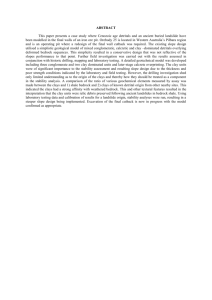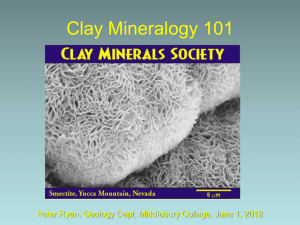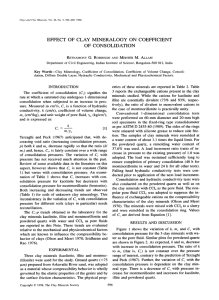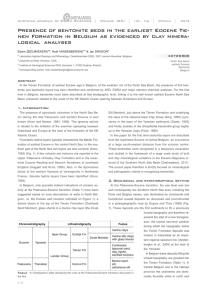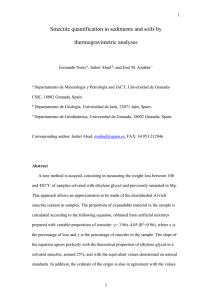Chapter 4
advertisement
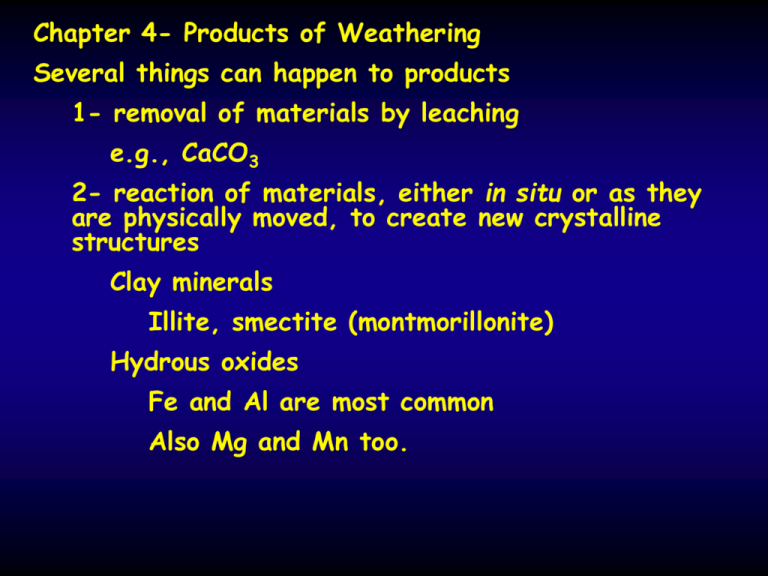
Chapter 4- Products of Weathering Several things can happen to products 1- removal of materials by leaching e.g., CaCO3 2- reaction of materials, either in situ or as they are physically moved, to create new crystalline structures Clay minerals Illite, smectite (montmorillonite) Hydrous oxides Fe and Al are most common Also Mg and Mn too. Clay minerals Mostly of silicate composition Hydrated Fe, Al, Mg- silicate structures in discrete layers These layered silicates are called phyllosilicates Subdivided into two classes - on structure and charge Structure 1:1 clay minerals 1:1 refers to how the crystal structures are arranged 1 octahedron attached to a tetrahedron 2:1 clay minerals 2:1 refers to how the crystal structures are arranged 1 octahedron attached to 2 tetrahedrons On charge Based on the amount of chemical substitution i.e., which ions are most easily mobilized and exchanged Example: Montmorillonite Na 0.33 (Al 1.67 Mg 0.33) Si4 O10 (OH) Mg substitutes for Al, replacing 1 of every 6 atoms creates a net charge imbalance that allows X 0.33 to balance the formula Since a number of ions can meet the charge requirement (in this case its Na) we use X as a generic variable term in the formula Water plays a critical role in many clay minerals Contains elements that act as bonding agents keeps the crystalline structure together Most notable are the H+ and the OH- cations and anions In many circumstances the water can be driven off or can facilitate ion substitution, especially in 2:1 clays e.g., smectite clays (montmorillonite) Building blocks of clay minerals Silica tetrahedron QuickTime™ and a TIFF (Uncompressed) decompressor are needed to see this picture. kTime™ and a essed) decompressor o see this picture. Hydroxyl octahedron tetrahedron Structure of Kaolinite A 1:1 phyllosilicate clay mineral Note the single tetrahedron attached to the octahedron Phyllosilicate mineral structures- including Kaolinite QuickTime™ and a TIFF (Uncompressed) decompressor are needed to see this picture. Forms of Smectite (a 2:1 clay) Montmorillonite - Mg form of smectite Both Al and Mg in the octahedral layer Beidellite- Al form of smectite Al in the octahedral sheet and substituting for Si in the tetrahedral sheet Nontronite - Fe variety of smectite Fe in the octahedral sheet and Al substituting for Si in the tetrahedral sheet Illite (a 2:1 clay mineral) Chemical formula is similar to muscovite Differs slightly because Al and Si substitute for one another allowing K+ to act as an interlayer bonding agent The K+ location in the structure of the layers is close to the negative charges Resultant chemical bond is strong enough to inhibit water squeezing in Limits the shrink swell capacity of the clay QuickTime™ and a TIFF (Uncompressed) decompressor are needed to see this picture. QuickTime™ and a TIFF (Uncompressed) decompressor are needed to see this picture. 2:1 clays structure Non-shrink/swell type e.g., Illite QuickTime™ and a TIFF (Uncompressed) decompressor are needed to see this picture. Shrink/swell type e.g., Smectite QuickTime™ and a TIFF (Uncompressed) decompressor are needed to see this picture. Unusual clay minerals often encountered Montmorillonite often results from the alteration of volcanic ash the end product is a bentonite clay In conditions with adequate drainage Mg is leached (instead of substituting) forming kaolinite instead of montmorillonite. Smectites commonly result from the weathering and alteration of basic composition rocks. Nontronite results from the alteration of basaltic glass. Chemical composition of clay minerals Tough to get clay chemical compositions Hard to get pure samples to run often clays have a tendency to be mixed layer clays the 2:1 clays mix with octahedral sheets (not part of 2:1 structure) When they do run chemical analysis… It’s really variable Chemical composition of clays Non crystalline and Crystalline Al and Fe compounds Non Xtln Allophane- common Al compound found in soils not quite crystalline, but not quite amorphous either Xtln Al crystalline minerals Gibbsite Boehmite Origins of clays Clay type vs. depth Clay types and soil orders Only 3 strong relationships between soil order and clay types Vertisols - montmorillonite Andisols - allophane Oxisols - oxides and kaolinite The remaining 8 orders can and do contain a whole range of clay minerals

